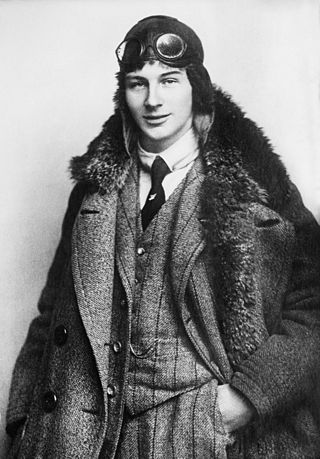
Anton Herman Gerard "Anthony" Fokker was a Dutch aviation pioneer, aviation entrepreneur, aircraft designer, and aircraft manufacturer. He produced fighter aircraft in Germany during the First World War such as the Eindecker monoplanes, the Dr.1 triplane and the D.VII biplane.

The Fokker Dr.I, often known simply as the Fokker Triplane, was a World War I fighter aircraft built by Fokker-Flugzeugwerke. The Dr.I saw widespread service in the spring of 1918. It became famous as the aircraft in which Manfred von Richthofen gained his last 17 victories, and in which he was killed on 21 April 1918.
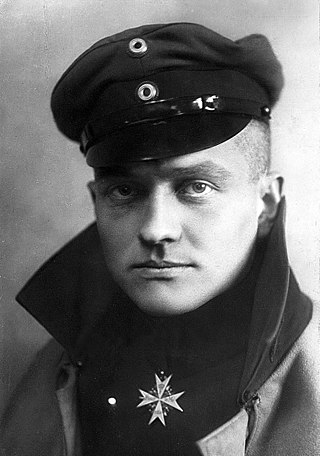
Manfred Albrecht Freiherr von Richthofen, known in English as Baron von Richthofen or the Red Baron, was a fighter pilot with the German Air Force during World War I. He is considered the ace-of-aces of the war, being officially credited with 80 air combat victories.

The Sopwith Triplane is a British single seat fighter aircraft designed and manufactured by the Sopwith Aviation Company during the First World War. It has the distinction of being the first military triplane to see operational service.

A triplane is a fixed-wing aircraft equipped with three vertically stacked wing planes. Tailplanes and canard foreplanes are not normally included in this count, although they occasionally are.

Lothar Siegfried Freiherr von Richthofen was a German First World War fighter ace credited with 40 victories. He was a younger brother of top-scoring ace Manfred von Richthofen and a distant cousin of Luftwaffe Field Marshal Wolfram von Richthofen, both of whom also became flying aces.
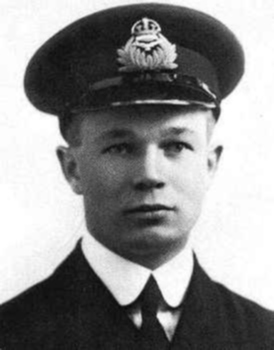
Arthur Roy Brown, was a Canadian flying ace of the First World War, credited with ten aerial victories. The Royal Air Force officially credited Brown with shooting down Manfred von Richthofen, the "Red Baron", although historians, doctors, and ballistics experts consider it all but certain that Richthofen was actually killed by a machine gunner firing from the ground.

The Blue Max is a 1966 war film directed by John Guillermin and starring George Peppard, James Mason, Ursula Andress, Karl Michael Vogler, and Jeremy Kemp. The film was made in DeLuxe Color and was one of the last movies filmed in CinemaScope. It was filmed entirely in Ireland, and included numerous location scenes shot in Dublin, Wickow and Cork. The plot is about a German fighter pilot on the Western Front during World War I. The screenplay was written by David Pursall, Jack Seddon, and Gerald Hanley, based on the novel of the same name by Jack D. Hunter as adapted by Ben Barzman and Basilio Franchina.

Werner Voss was a World War I German flying ace credited with 48 aerial victories. A dyer's son from Krefeld, he was a patriotic young man while still in school. He began his military career in November 1914 as a 17‑year‑old Hussar. After turning to aviation, he proved to be a natural pilot. After flight school and six months in a bomber unit, he joined a newly formed fighter squadron, Jagdstaffel 2 on 21 November 1916. There he befriended Manfred von Richthofen.

The Deutsche Luftstreitkräfte – known before October 1916 as Die Fliegertruppen des deutschen Kaiserreiches – was the air arm of the Imperial German Army. In English-language sources it is usually referred to as the Imperial German Air Service, although that is not a literal translation of either name. German naval aviators of the Marine-Fliegerabteilung were an integral part of the Imperial German Navy. Both military branches operated aeroplanes, observation balloons and airships.
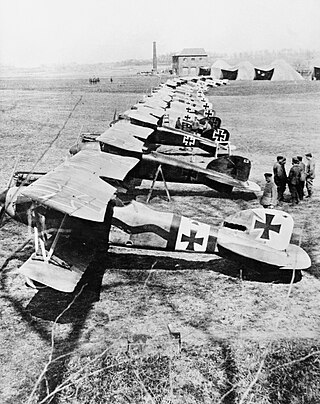
Royal Prussian Jagdstaffel 11 was founded on 28 September 1916 from elements of 4 Armee's Kampfeinsitzerkommandos 1, 2 and 3 and mobilized on 11 October as part of the German Air Service's expansion program, forming permanent specialised fighter squadrons, or "Jastas". It became the most successful fighter squadron in the Luftstreitkräfte.
JagdgeschwaderI of World War I, was a fighter wing of the German Luftstreitkräfte, comprising four Jastas. The first unit of its type formed under that classification, JG I was formed on 24 June 1917, with Manfred von Richthofen as commanding officer, by combining Jastas 4, 6, 10 and 11. JG I became known as "The Flying Circus" or "Richthofen's Circus" because of the bright colours of its aircraft, and perhaps also because of the way the unit was transferred from one area of Allied air activity to another – moving like a travelling circus in trains, and frequently setting up in tents on improvised airfields.
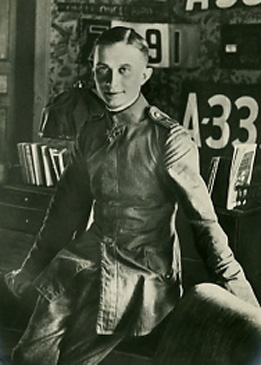
OberleutnantKurt Robert Wilhelm Wolff PlM was one of Imperial Germany's highest-scoring fighter aces during World War I. The frail youthful orphan originally piloted bombers before being picked by Manfred von Richthofen to join Jagdstaffel 11 in the burgeoning Imperial German Air Service. Under the tutelage of Richthofen, Wolff would shoot down 33 enemy aircraft in four months, including 22 victims during the Royal Flying Corps' disastrous Bloody April, 1917. Wolff scored victories so rapidly he outran the Prussian awards system; although the Pour le Merite was customarily awarded after a fighter ace's 20th victory, Wolff's was not received until after his 29th.

Manfred von Richthofen, also known as the "Red Baron", was a fighter pilot with the German Air Force during World War I and one of the most famous aviators in history, as well as the subject of many books, films and other media. The following is a list of mentions of him in popular culture.

The Fokker V.6 was a prototype fighter triplane developed in Germany during World War I in parallel with the V.5, from which the famous Dr.I was developed. The V.6 was powered by an 89 kW (120 hp) Mercedes D.II liquid-cooled engine. The heavier engine required larger wings, with the lower wing being placed just below the fuselage. A modification to add fairings to the lower wing fuselage junction was implemented after the first tests. The V.6 was abandoned in October 1917 due to being inferior in maneuverability to the newer Dr.I.
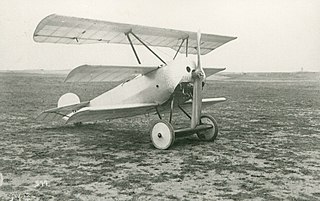
The Fokker V.4 was a prototype German fighter aircraft of World War I. Inspired by the successful Sopwith Triplane, Anthony Fokker chose to create a triplane fighter. Reinhold Platz was responsible for the design. The V.4 looked very much like the later Dr.I, but is easily recognized by the lack of interplane struts. All three wings were cantilever and the lower two wings had the same span. The rudder was balanced, but the ailerons and elevators lacked horn balances.

Fokker V.8 was a five-winged aircraft built by Fokker for the Luftstreitkräfte during World War I.

A Jagdstaffel was a fighter Staffel (squadron) of the German Imperial Luftstreitkräfte during World War I.
Richard Raymond-Barker, MC was a British aviator and flying ace, credited with six aerial victories in the First World War. He was Manfred von Richthofen's penultimate victim.
Merrill Samuel Taylor was a Canadian flying ace of the First World War. He was credited with seven aerial victories while flying a Sopwith Camel fighter for the Royal Naval Air Service and, later, the Royal Air Force. He touched off the air battle that resulted in the death of the war's leading ace, Manfred von Richthofen, on 21 April 1918. On 2 May 1918, he killed German ace Hans Weiss for his fifth victory. Taylor was killed in action by Franz Büchner on 7 July 1918.


















